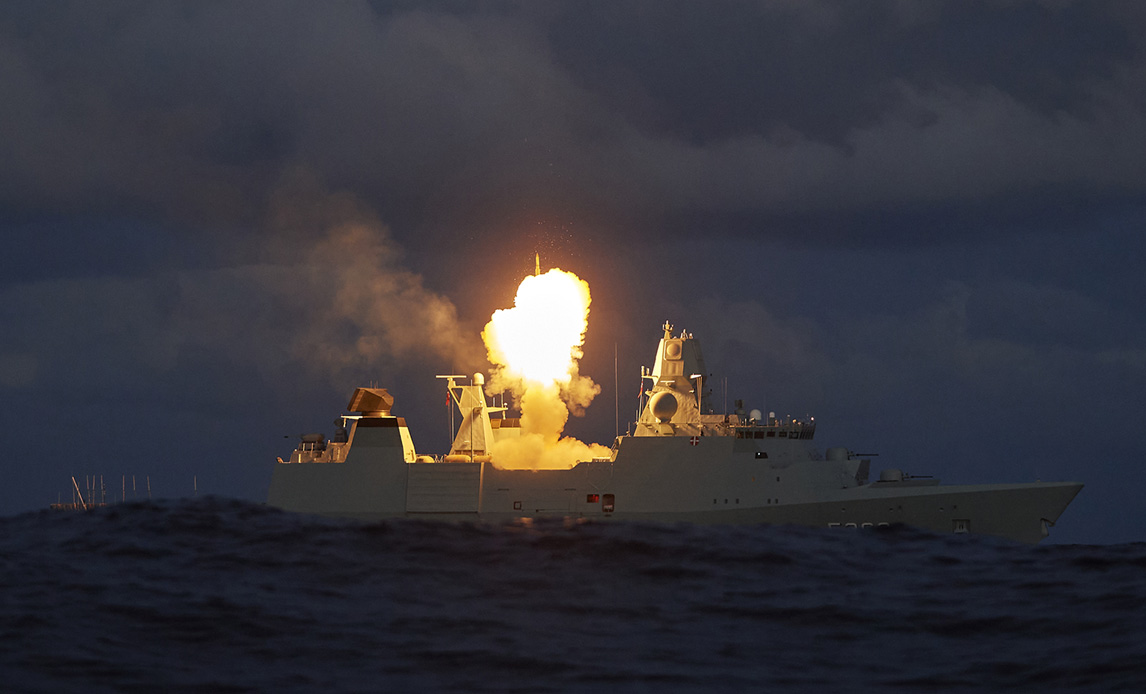The Armed Forces test launches SM-2 missile
A Danish warship for the first time has fired a SM-2 missile. The Danish Armed Forces and The Danish Ministry of Defence Acquisition and Logistics Organisation are integrating the SM-2 missiles for use in the Danish frigates of the Iver Huitfeldt class. In the future, the frigates will be able to fight enemy aircraft at a long distance.

The missile being fired from the frigate Niels Juel. Photo: Danish Armed Forces.
By the Danish Defense Command
On May 5 a SM-2 missile was fired from a Danish warship for the first time. The firing was a so-called First of Class (FOC) shooting, and was conducted by the Danish Ministry of Defence Acquisition and Logistics Organisation on board the frigate Niels Juel. It was an important step in the process of arming the three Iver Huitfeldt-class frigates with SM-2 missiles.

The missile has been launched. Photo: Danish Armed Forces
“It is a very important milestone to have the missiles tested on our frigates of Iver Huitfeldt class. When we subsequently get the missiles installed on the three frigates in the class, The Armed Forces can seriously utilize these units for what they were originally purchased and designed for, namely area air defense. The frigates already have radars, other sensors, and a well-trained crew, which enable the frigates to monitor an airspace closely and accurately and quickly detect enemy aircraft or missiles. With the SM-2 missiles, the frigates will be able to fight these possibly enemy aircraft and missiles at a longer distance, and they will thus make a significant contribution to e.g. the air defense of Denmark. It simply makes the frigates better suited for air defense, which is important in relation to the defense of Denmark and it supports the demand from NATO, "says Rear Admiral Torben Mikkelsen, Admiral Danish Fleet.
When the new missiles are fully operational, the frigates at short notice can deploy for defense tasks both in conflict areas around the world and in the defense of Denmark and Danish territory.
At the same time, the upgrade means that the frigates will be a more valuable asset for NATO, as the ability to deploy a ship with area air defense capabilities is in demand by NATO. Denmark's contribution to NATO will thus be improved.
Long-term project
Prior to the launch, the Danish Ministry of Defence Acquisition and Logistics Organisation (DALO) has been preparing the missile's installation and testing for several years. The procurement consists of several parts. The missile itself is procured through the US Navy. However, in addition to the acquisition of these, a great deal of work has been done at DALO to update electronics and software on board the frigate.
Likewise, the DALO has prepared the so-called MK41 launcher, which was built into the ships from the start and from which the missiles are fired. On land, facilities for the missiles have been set up at the same time.
“We have worked for many years towards being able to implement this capacity. It is therefore a great pleasure that it all came together in a successful first firing last night. Now we look forward to being able to use the data from the test launch to the further work towards a final implementation of the missile system, "says Anders Skeel Bytzau, project manager for the acquisition of the SM-2 missile system at DALO.

Photo: Danish Armed Forces
Area air defense
The new missiles will contribute to area defense.
“Area defense is crucial for a naval force or an aircraft carrier group to operate freely. With the SM-2 missiles, the Danish frigates are better equipped for escorts of other ships and protecting a naval force, and even the area where the force operates, against enemy missiles or aircraft,” says naval captain Simon E. Schultz-Larsen, commander of the frigate Niels Juel.
The missile launch is a test to ensure that the systems are working and interacting properly. It took place in a shooting range at sea at Andôya Space Defense (ASD) in the northern part of Norway.